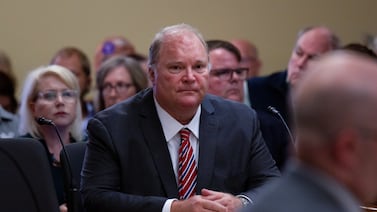Votebeat is a nonprofit news organization reporting on voting access and election administration across the U.S.
This news analysis was originally distributed in Votebeat’s free weekly newsletter. Sign up to get future editions, including the latest reporting from Votebeat bureaus and curated news from other publications, delivered to your inbox every Saturday.
Several provisions of President Donald Trump’s executive order on elections have run into obstacles in court. But others are quietly moving ahead, at least for now, with big potential implications for state and local election officials and the voting systems they rely on.
In Montgomery County, Ohio, for example, residents can choose to mark their ballots either by hand, or using a ballot-marking device that prints out a paper ballot with a summary of their choices, alongside a machine-readable code reflecting those choices. Voters can verify their selections before submitting their ballots into a tabulator, which scans the code and records the votes.
At least 85% of voters in a typical election choose the option that relies on the machine-readable codes, Jeff Rezabek, the county elections director, estimated.
So Rezabek is closely watching what happens with a provision in the executive order that calls for mostly banning the use of such codes (except where required for disability access), and what it would mean for the millions of dollars’ worth of already-certified voting equipment he can’t easily or quickly replace.
Experts consider systems with a voter-verifiable paper record to be the gold standard for election security. But some critics have argued that when these systems use a code for faster counting, voters have no way of knowing whether the code accurately reflect their choices, even though the results can be checked later.
The executive order instructs the U.S. Election Assistance Commission to work the barcode ban into a revision of the Voluntary Voting System Guidelines, the certification standards that most states rely on for their voting equipment. And the multistep process of altering the standards is already beginning.
An initial step is set for July 2, when the U.S. EAC has called a meeting of its Technical Guidelines Development Committee, a group of mainly election officials and technical experts.
The EAC’s meeting notice says the technical committee, which currently has several vacancies, will consider a draft of updated guidelines at that meeting.
EAC Chairman Donald Palmer, in an emailed response to questions from Votebeat, said there have “been security concerns expressed by the Executive Branch, state legislatures, and stakeholders on both sides of the aisle” about the use of barcodes and QR codes, and the July 2 meeting is a required step in the EAC’s regular update process.
“With this review, the EAC is being responsive to election officials’ needs and the evolving security demands of our elections,” he said. “Gathering feedback from our boards and the public is a chance for the community to provide its essential input on those changes.”
Building voting systems to new standards, testing them in federally accredited laboratories, and certifying them takes a long time. The last set of revised guidelines, VVSG 2.0, were adopted in 2021, but no systems certified under those guidelines have yet hit the market, though some are going through the process now.
It isn’t clear what the EAC will do if the technical committee declines to endorse revised guidelines on the barcodes. But election officials know the general public isn’t closely following the federal rule-making process, and may not understand that equipment certified under the previous guidelines can be used securely and produce accurate results. They are worried that the executive order has already sown public doubt about the integrity of voting equipment.
“It doesn’t entirely matter what happens through the standards process because voters are not going to hear that part,” said Amy Cohen, executive director of the National Association of State Election Directors. “Voters are hearing the president said this, and so that optics challenge is going to be very difficult for elections in 2025 and beyond.”
State lawmakers, too, could also try to act on their own to carry out the president’s priorities, regardless of what happens with the executive order. That could prove expensive for local jurisdictions. Rezabek said Ohio state lawmakers recently considered legislation that would require localities to use election equipment certified to VVSG 2.0, which would require buying new machines.
“Then we’re in trouble because one, I have no funding,” he said. And even if he did, he said, “the manufacturer doesn’t have it to give to us.”
Rezabek, a former Republican state lawmaker, worked with Ohio’s election officials association to address their concerns and lobby state legislators against that. They haven’t adopted such a requirement — yet.
Election officials in other states are also worried. In Texas, state Elections Director Christina Adkins told county election officials on a call this month that her office has been “in discussions,” with the EAC, which she said “understands the impact of any decisions they make in this area.”
“I want to make it very clear, though, that we are bound to the federal certifications,” Adkins said. “Our state law requires that, so any changes to the federal certifications would generally apply to Texas systems as well.”
Some counties are already moving to replace equipment because of the executive order. In Williamson County, Texas, commissioners voted to spend more than $1 million to replace their current voting system, which relies on barcodes, with equipment that does not, according to local news reports.
Los Angeles County, the nation’s largest voting jurisdiction, uses customized voting equipment, and publicly posts a key to deciphering its QR code, to reassure the public that the codes can be checked to verify that they accurately reflect voters’ choices.
Election officials have been “assessing the impact” of having to modify or replace more than 31,000 ballot marking devices that are valued at more than $141 million, county elections chief Dean Logan wrote in court filings connected to one of the lawsuits challenging the executive order.
Money is just one consideration.
“Even if the EAC goes forward, changes these standards, and tries to apply them to existing voting systems, the time frame for making that kind of significant change to a voting system … that is usually a multiple year process to do that,” Logan said in an interview with Votebeat. “So part of what is not well-constructed in that order is understanding the timeline.”
Votebeat Texas reporter Natalia Contreras contributed.
Carrie Levine is Votebeat’s editor-in-chief and is based in Washington, D.C. Contact Carrie at clevine@votebeat.org.



